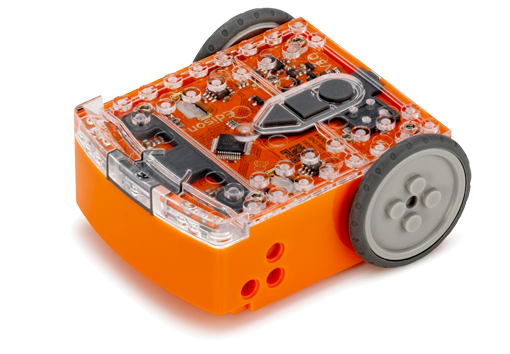Lesson plan overview
Most lessons have been designed to be completed in 90 minutes; however this will vary based on a student’s age and ability. All lesson plans have been linked to the Australian curriculum. Please see a complete list of references at meetedison.com/.
Lesson 1: Get familiar and set up
Technology skills – Students familiarise themselves with the programming environment and how to download a program to the robot.
- Set up and become familiar with Edison using barcode programs
- Open software and become familiar with how to move icons
- Download test program
Lesson 2: Robot movement – driving
Introduction to sequential programming – Students learn how the robot responds to command icons and bring together the concepts of time, speed and distance.
Program 1 – Drive the robot forward (Worksheet 2.1)
Program 2 – Drive the robot backward (Worksheet 2.2)
Program 3 – Drive the robot forward and backward (Worksheet 2.3)
Program 4 – Speed play (Worksheet 2.4)
Lesson 3: Robot movement – turning
Sequential programing and basic geometry – Students learn how the robot responds to time and geometry and how they can achieve driving control of the robot.
Program 1 – Right turn (Worksheet 3.1)
Program 2 – Left turn (Worksheet 3.2)
Program 3 – Right and then left turn (Worksheet 3.3)
Program 4 – Mini maze (Worksheet 3.4)
Lesson 4: Maze challenge and Mexican wave
Reinforce learning – Students use knowledge from lessons 1 through 3 to achieve two fun open ended activities.
Program 1– Driving challenge (Worksheet 4.1)
Program 2 – Mexican wave robot style (Worksheet 4.2)
Lesson 5: Design brief 1 – My program
Creative thinking and problem solving – Students come up with their own challenge and conceptualise how the robot can provide a solution. Students may select their own topic, state the program’s purpose and explain where it could be used in the real world.
- Identify a problem that the robot can solve or a fun movement to music
- Describe the problem or the movements the robot needs to make
- Write the program and test it
- Failure – The first attempt is never successful. Document it and Keep trying!
- Describe the programming icons used and what they do
- Demo – Students demonstrate their robot’s program to the class
Lesson 6: Clap sensing
Introduction to inputs (sensors) – Students learn how to make the robot respond to outside stimulus (claps). This lesson also includes a fun class activity.
Program 1 – Flash LED in response to a clap (Worksheet 6.1)
Program 2 – Drive in response to a clap (Worksheet 6.2)
Program 3 – Dance in response to clapping (Worksheet 6.3)
Lesson 7: Detect obstacles
Introduction to the concept of obstacle detection and artificial intelligence – Students program the robot to make decisions (artificial intelligence) in response to obstacles in the robot’s environment.
Understanding infrared obstacle detection (Worksheet 7.1)
Program 1 – Detect an obstacle and stop (Worksheet 7.2)
Program 2 – Detect an obstacle and avoid (Worksheet 7.3)
Program 3 – Detect an obstacle and avoid in a loop (Worksheet 7.4)
Program 4 – Right and left obstacle detection (Worksheet 7.5)
Lesson 8: Line sensing and tracking
Industrial like robotic behaviour – Students learn about basic robot sensing and control similar to that used in advanced automated factories and warehouses.
Understanding the line tracking sensor (Worksheet 8.1)
Program 1 – Drive until a black line (Worksheet 8.2)
Program 2 – Drive inside a border (Worksheet 8.3)
Program 3 – Follow a line (Worksheet 8.4)
Video – Humans need not apply
Lesson 9: Respond to light
Environmental measurement and programming mathematics – Students learn about measuring light levels, storing them in memory and performing mathematics to control the robots behaviour.
Understanding variables (Worksheet 9.1)
Program 1 – Light level alarm (Worksheet 9.2)
Program 2 – Automatic lights (Worksheet 9.3)
Program 3 – Light following (Worksheet 9.4)
Animal behaviours in robotics
Lesson 10: Design brief 2 – My program
Creative thinking and problem solving – This is the second design brief where students come up with their own challenge and conceptualise how the robot can provide a solution
- Identify a problem that the robot can solve or action it can take
- Describe the problem or the action the robot needs to make
- Write the program and test it
- Failure – The first attempt is never successful. Document it and Keep trying!
- Describe the programming icons used and what they do
- Demo – Students demonstrate their robot’s program to the class

